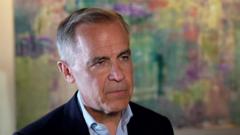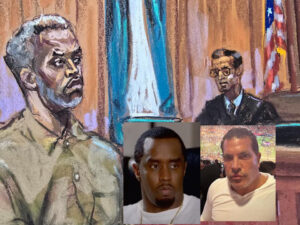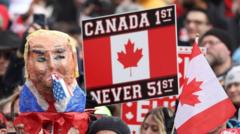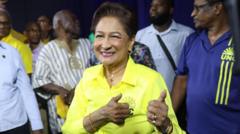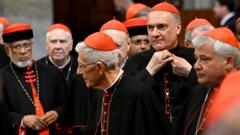With just hours left before a critical election, Canadian political fortunes are dramatically shifting as both sides rally their bases in a battle that hinges on their responses to American pressures.
A Political Face-Off: Canada’s Election on a Knife's Edge
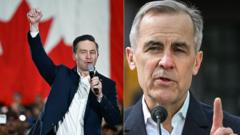
A Political Face-Off: Canada’s Election on a Knife's Edge
Tension Rises as Canada Prepares for Pivotal Election Amidst U.S. Influence
At a spirited rally in London, Ontario, Liberal leader Mark Carney claimed, "President Trump seeks to break us so that America could own us," eliciting boos from the crowd—underscoring the election’s fierce nationalism. Meanwhile, Conservative leader Pierre Poilievre had already been drawing large crowds, championing a campaign focused on “Bring it Home,” which speaks to rising Canadian patriotism amid U.S. trade threats. As the election day approaches, both leaders appear to be caught in the shadows of former U.S. President Trump, with polls suggesting a tight race.
Though Trump’s threats loom large, Poilievre, who quickly pivoted his focus toward the dissatisfaction felt by those blaming the Liberal Party for economic struggles, has intensified his attacks on the recent “Lost Liberal decade.” His approach resonates with many, including a hopeful Eric Gionet, who fears for his daughters’ financial future as housing opportunities dwindle.
However, the political landscape shifted unexpectedly when Justin Trudeau’s resignation opened the door for Carney, who now leads the Liberals in a surprising comeback. His diplomatic expertise, having navigated Canada through the 2008 financial crisis, is reassuring voters like Mike Brennan, a longtime Liberal supporter reevaluating his allegiance in light of Trudeau’s unpopularity.
The election has evoked memories of past political upheavals, as polls from last year indicated the Conservatives held an impressive lead over the Liberals. The tides turned when a series of significant events—including Trump’s return to the presidency—realigned voter sentiments, leaving both parties neck-and-neck entering election day.
Moreover, the unfamiliarity of Carney as a first-time candidate gives pause to some voters who question whether one man can shift the underlying political dynamics. Voter Gwendolyn Slover expressed skepticism: “It’s the same party, he’s one person. And he’s not going to change anything,” signaling a wider apprehension about change.
Despite the noise surrounding their electoral pitches, both leaders emphasize the importance of addressing the U.S.-Canada relationship while articulating visions for a prosperous future. “It’s time for experience, not experiments,” Carney argues, bolstering his claim to stability against Poilievre’s call for transformative change: “We can take back control of our lives and build a bright future.”
As the clock winds down, Canadians find themselves at a historic crossroads, forcing them to confront not just their immediate priorities but their long-term political identity as well. With smaller parties unable to compete effectively, the focus sharpens on these two giants, igniting a more passionate electorate as they gear up to cast their votes.

